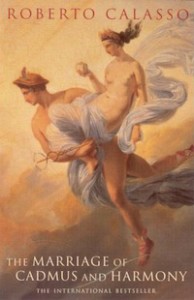One of the proposals for my sabbatical was to further read in areas of interest in my interdisciplinary work in film and art. I would like to share a few thoughts on one particular book that has had a lasting impression. Roberto Calasso is one of the great polymaths writing today. He writes on literature, art, culture, and philosophy. His books are difficult to define. The book that made him famous is The Marriage of Cadmus and Harmony.
 The book is a rhapsody on the origins of Greek mythology. But rather than offer another attempt to retell the myths, such as classics like Robert Graves’ The Greek Myths, Edith Hamilton’s Mythology, or Gustav Schwab’s Gods and Heroes of Ancient Greece, Calasso’s book is more of a work of art. He begins with where the myths begin… with the abduction of a beautiful young woman. From there his tale weaves together strands of Homer, Hesiod, Herodotus, Plutarch, Pliny, Sophocles, Euripides…etc. He moves through the permutations of the narratives as one might have heard them spoken in the oral tradition. The endnotes explain the matrix of sources. Many familiar – many not available in any English translation. Calasso’s idea is that the history of myth is as Joseph Campbell once described it – a grand narrative of our social values and truths.
The book is a rhapsody on the origins of Greek mythology. But rather than offer another attempt to retell the myths, such as classics like Robert Graves’ The Greek Myths, Edith Hamilton’s Mythology, or Gustav Schwab’s Gods and Heroes of Ancient Greece, Calasso’s book is more of a work of art. He begins with where the myths begin… with the abduction of a beautiful young woman. From there his tale weaves together strands of Homer, Hesiod, Herodotus, Plutarch, Pliny, Sophocles, Euripides…etc. He moves through the permutations of the narratives as one might have heard them spoken in the oral tradition. The endnotes explain the matrix of sources. Many familiar – many not available in any English translation. Calasso’s idea is that the history of myth is as Joseph Campbell once described it – a grand narrative of our social values and truths.
Some of the best moments for me are those parts of the book where he enters in and comments or questions the nature and interpretations of those stories. For instance, the alternate narrative of Helen who was never even in Troy. The woman who precipitated the Trojan/Greek war was actually a double… a phantom. One reference in Herodotus says she was kept in Egypt. Calasso muses about why Homer decided to give us the other story? This raises the ante on what it is exactly we care about most…ideas or realities?
The book is composed of 12 chapters. It covers the enormous range of what Graves called the “disorganized corpses of Greek mythology.” The final chapter gets you into the title of the book. It tells the story of the tragic fate and aftermath of the marriage of Cadmus and Harmony. It ends with Cadmus’ gift – letters…” those fly’s feet” that became the Phoenician language in written form, essentially the transition of oral to written text.
It is a pleasure to teach art history to Houghton students. I seldom have to pause to explain who Jacob is or why Absolom is hanging by his hair in a tree. They know the stories of the Hebrew Bible (what we call the Old Testament) and it’s companion, the New. Sometimes I prod them into interpretation or to ponder the interconnectedness of the stories. How Adam and Jesus are mirrored ideas in the text as Paul expounds on the significance in a kind of literary criticism of the text. It is great to teach students who know the stories. Houghton students read well as “moral readers”…getting what the text is trying to teach… but not always as “experiential readers.” Some of the stories are there to makes us feel things.
Calasso’s book is a remarkable work that will generate new ideas about familiar and not so familiar stories. I recommend this to anyone looking for a highly crafted rich narrative on these foundational stories to western culture. Read him after you have read Ovid. The Myths of Greece (and the Roman counterparts) form the other half of what all those magnificent paintings in the Louvre, the Prado and the Met are largely about. Who was Pelops? Why is that peninsula call the Peloponnese? Calasso has a great story to relate on that theme. Learn about the curse upon the house of Atreus or the meaning of the oracles. Read the heart breaking investigation that Plutarch took to discover who Charila in Delphi was. These and so many more are the reason this is such a wise, erudite investigation into these sometimes familiar and often times obscure stories.
Did the Greeks believe in their myths? Yes and no. Most of these stories existed to explain the forces of life and fate. On the one hand they are a way to address the season, the mystery of attraction and the reason why a bronze spear misses the foe at whom it was thrown. Calasso has a very refined sense of the balance between story and meaning. It is a book not quite like any you are going to encounter on this old subject.
